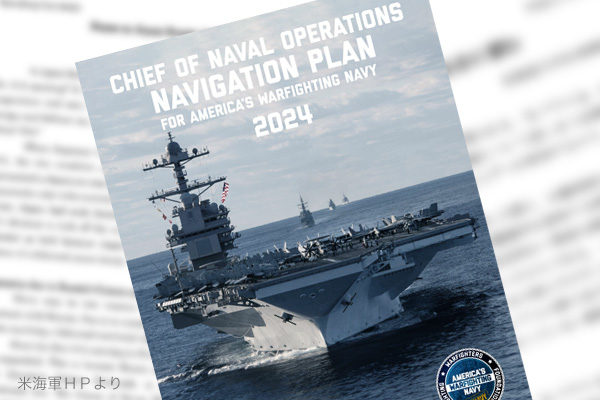On September 19, U.S. Chief of Naval Operations Lisa M. Franchetti, the top U.S. Navy officer, released the Navigation Plan for America’s Warfighting Navy 2024. The plan updates the previous version published in 2022 by her predecessor, based on lessons learned from naval warfare in the Black Sea during the Russia-Ukraine war and the fight against Yemen's Houthi rebel group in the Red Sea, as well as situational changes like the military use of robotic platforms and autonomous systems. After reading the Plan, I feel that there is a big gap between the Japanese and U.S. security perceptions.
Perception gap over threats to seabed infrastructure
In the description on the security environment, the Navigation Plan writes how seabed infrastructure such as undersea pipelines and cables are vulnerable to an attack. However, in Japan’s Defense White Paper, even in the latest 2024 edition published in July, the only mention of threats to seabed infrastructure is the part introducing Britain’s dispatch of an aircraft carrier strike group to Nordic waters to defend important undersea infrastructure mainly in the Baltic Sea.
As far as an aircraft carrier is concerned, the Chinese Navy’s aircraft carrier Liaoning sailed through Japan’s contiguous zone between Yonaguni and Iriomote Islands in Okinawa Prefecture on September 18. After the Chinese Navy sent a survey ship into Japan’s territorial waters in the Tokara Strait of Kagoshima Prefecture on August 31, a Chinese Foreign Ministry spokesman claimed that the Tokara Strait, which consists only of Japanese territorial waters and does not meet the requirements for an international strait, is an international strait. On August 26, an intelligence-gathering aircraft of the People’s Liberation Army became the first Chinese military aircraft to violate Japan’s territorial airspace off the coast of the Danjo Islands in Nagasaki Prefecture. The series of Chinese military actions may be testing Japan’s reactions.
Although Chinese naval ships’ navigation in Japan’s contiguous zone or innocent passage through territorial waters do not violate international law, Japan should send Maritime Self-Defense Force ships to pass through the Taiwan Strait, recognized as an international strait by countries other than China, as a countermeasure to these Chinese actions. Warships of Britain, Germany, France, and Canada as well as the United States have already passed through the Taiwan Strait many times.
Different sense of urgency regarding a Taiwan contingency
The Navigation Plan contains statements in gothic type throughout that “by 2027” specific various goals should be achieved. On the other hand, among the nine candidates running for Japan’s ruling Liberal Democratic Party leader election, few have put forward policies based on the assumption that a Taiwan contingency could occur during his or her three-year term as LDP leader, or as Japan’s prime minister.
Since late last year, the monthly magazine Proceedings published by the U.S. Naval Institute has been running a series of special feature articles on preparations for a potential China-Taiwan war in 2026, a year before 2027. In the current September issue, a Marine Corps Lieutenant Colonel wrote an article titled “Diplomacy for Better Stand-in Force Access in Japan,” arguing that diplomatic efforts are necessary to expedite the deployment of U.S. troops as it takes two to three digit days after application under the current U.S.-Japan Status of Forces Agreement. This article won second prize in an essay contest.
According to the Chinese Communist Party-affiliated Global Times, a Chinese Foreign Ministry spokesman warned Japan and the U.S. on September 18 that a U.S. plan to deploy missile systems in Japan “will seriously heighten regional tensions.” At a LDP leader election campaign rally in Okinawa, however, none of the nine candidates actively advocated supporting the rapid deployment of U.S. missile forces. Instead, some pledged to reduce the burden of U.S. military bases on Okinawa and revise the Status of Forces Agreement in favor of Japan. This also shows a lack of urgency on the part of Japan.
Fumio Ota is a Planning Committee member at the Japan Institute for National Fundamentals. He is a retired Vice Admiral of the Japan Maritime Self-Defense Force and a former Director of Defense Intelligence Headquarters.


